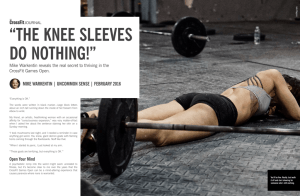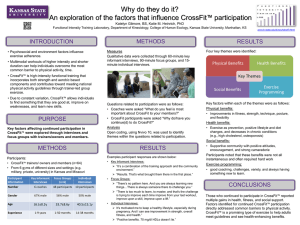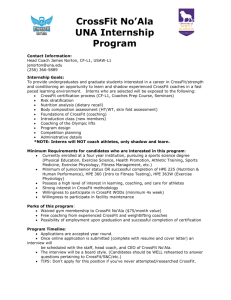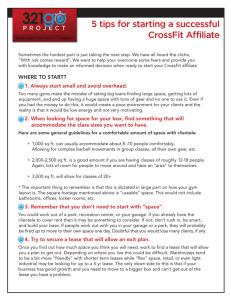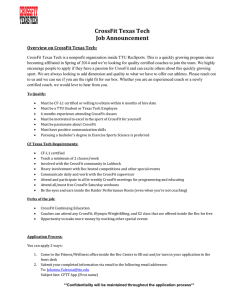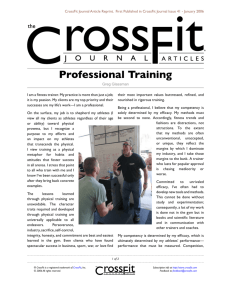CrossFit Participation Decreases Systolic Blood Pressure: an Examination by Age RESULTS
advertisement
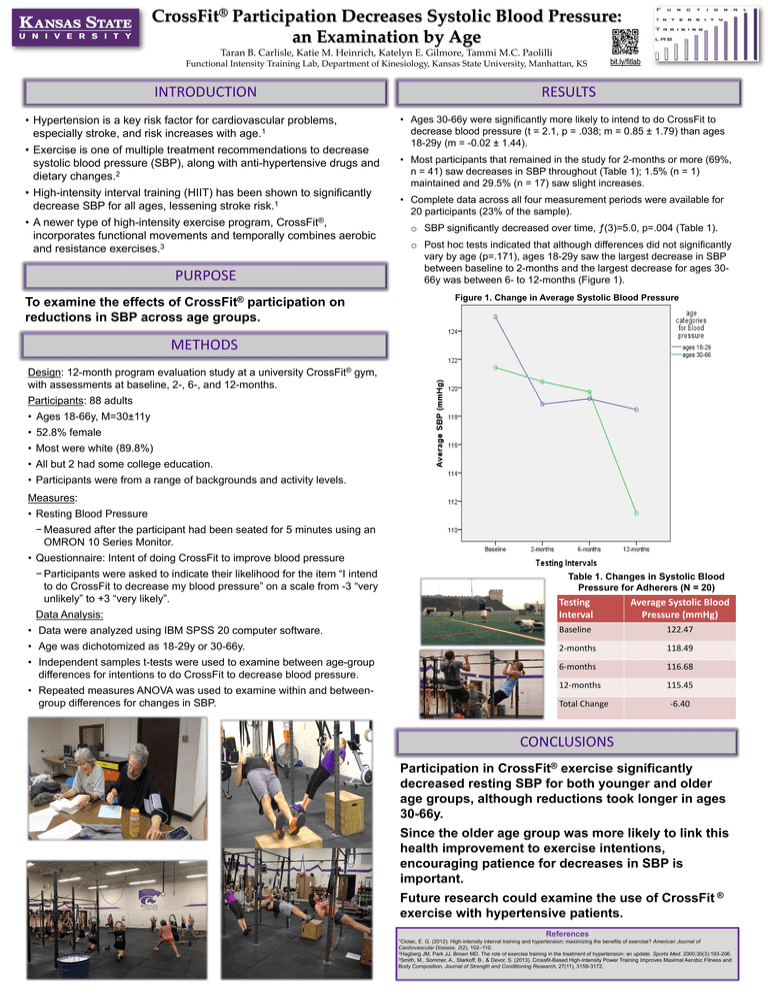
® CrossFit Participation Decreases Systolic Blood Pressure: an Examination by Age Taran B. Carlisle, Katie M. Heinrich, Katelyn E. Gilmore, Tammi M.C. Paolilli Functional Intensity Training Lab, Department of Kinesiology, Kansas State University, Manhattan, KS INTRODUCTION • Hypertension is a key risk factor for cardiovascular problems, especially stroke, and risk increases with age.1 • Exercise is one of multiple treatment recommendations to decrease systolic blood pressure (SBP), along with anti-hypertensive drugs and dietary changes.2 • High-intensity interval training (HIIT) has been shown to significantly decrease SBP for all ages, lessening stroke risk.1 • A newer type of high-intensity exercise program, CrossFit®, incorporates functional movements and temporally combines aerobic and resistance exercises.3 PURPOSE bit.ly/fitlab RESULTS • Ages 30-66y were significantly more likely to intend to do CrossFit to decrease blood pressure (t = 2.1, p = .038; m = 0.85 ± 1.79) than ages 18-29y (m = -0.02 ± 1.44). • Most participants that remained in the study for 2-months or more (69%, n = 41) saw decreases in SBP throughout (Table 1); 1.5% (n = 1) maintained and 29.5% (n = 17) saw slight increases. • Complete data across all four measurement periods were available for 20 participants (23% of the sample). o SBP significantly decreased over time, ƒ(3)=5.0, p=.004 (Table 1). o Post hoc tests indicated that although differences did not significantly vary by age (p=.171), ages 18-29y saw the largest decrease in SBP between baseline to 2-months and the largest decrease for ages 3066y was between 6- to 12-months (Figure 1). Figure 1. Change in Average Systolic Blood Pressure ® CrossFit To examine the effects of participation on reductions in SBP across age groups. METHODS Design: 12-month program evaluation study at a university CrossFit® gym, with assessments at baseline, 2-, 6-, and 12-months. Participants: 88 adults • Ages 18-66y, M=30±11y • 52.8% female • Most were white (89.8%) • All but 2 had some college education. • Participants were from a range of backgrounds and activity levels. Measures: • Resting Blood Pressure − Measured after the participant had been seated for 5 minutes using an OMRON 10 Series Monitor. • Questionnaire: Intent of doing CrossFit to improve blood pressure − Participants were asked to indicate their likelihood for the item “I intend to do CrossFit to decrease my blood pressure” on a scale from -3 “very unlikely” to +3 “very likely”. Table 1. Changes in Systolic Blood Pressure for Adherers (N = 20) Testing Interval Average Systolic Blood Pressure (mmHg) • Data were analyzed using IBM SPSS 20 computer software. Baseline 122.47 • Age was dichotomized as 18-29y or 30-66y. 2-months 118.49 • Independent samples t-tests were used to examine between age-group differences for intentions to do CrossFit to decrease blood pressure. 6-months 116.68 12-months 115.45 Data Analysis: • Repeated measures ANOVA was used to examine within and betweengroup differences for changes in SBP. Total Change -6.40 CONCLUSIONS Participation in CrossFit® exercise significantly decreased resting SBP for both younger and older age groups, although reductions took longer in ages 30-66y. Since the older age group was more likely to link this health improvement to exercise intentions, encouraging patience for decreases in SBP is important. Future research could examine the use of exercise with hypertensive patients. ® CrossFit References 1Ciolac, E. G. (2012). High-intensity interval training and hypertension: maximizing the benefits of exercise? American Journal of Cardiovascular Disease, 2(2), 102–110. 2Hagberg JM, Park JJ, Brown MD. The role of exercise training in the treatment of hypertension: an update. Sports Med. 2000;30(3):193-206. 3Smith, M., Sommer, A., Starkoff, B., & Devor, S. (2013). Crossfit-Based High-Intensity Power Training Improves Maximal Aerobic Fitness and Body Composition. Journal of Strength and Conditioning Research, 27(11), 3159-3172.
